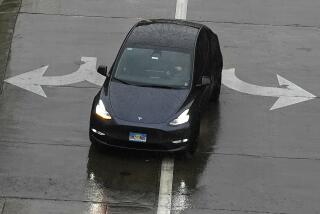Plenty of cars, too few buyers
- Share via
The sea of new cars, 57,000 of them, stretches for acres along the Port of Baltimore. They are imports just in from foreign shores and exports waiting to ship out -- Chryslers and Subarus, Fords and Hyundais, Mercedes-Benzes and Kias. But the customers who once bought them by the millions have largely vanished, and so the cars continue to pile up, so many that some are now stored at the nearby airport.
The backlog exists because many of the factors that contributed to the collapse of the housing bubble -- cheap credit, easy financing, excessive production, consumers buying more than they could afford -- undermined another large and vital American industry.
“There was a car bubble,” said Steven Rattner, whom President Obama recruited to head a Treasury Department group charged with finding solutions to the mountain of problems facing the American auto industry. “We had this artificially high sales rate.”
During the boom years of the early- and mid-2000s, automakers were selling more than 16 million cars a year in the United States. They are on pace to sell fewer than 10 million this year. General Motors posted a 44.5% drop in March compared with the same month a year earlier. Ford’s sales tumbled 41.3%. Chrysler’s fell 39.3%. Toyota’s sales fell 39% and Honda’s dropped 36.3%.
One of the key objectives of the auto task force is figuring out a sustainable number of annual auto sales. Only then can it determine the best way forward for U.S. automakers.
“You had a huge number of cars being sold,” Rattner said, “so I don’t think it is prudent to assume the sale levels are going back to those levels.”
What drove sales so high in the first place? In short, the same confluence of confidence and easy cash that fueled the housing boom.
“Consumers felt good about their future,” said Mark Pregmon, a SunTrust Bank executive and chairman of the automotive finance committee of the Consumer Bankers Assn. “It was riding the wave of the ‘go’ economy. Stocks were rising. Equity in houses was rising. People felt they could just borrow off their house. Their house was their ATM machine.”
Car companies did their part to entice consumers.
“Loose credit, incentives, leasing -- it really kind of fed the beast,” said Jeff Schuster, executive director of forecasting for J.D. Power and Associates. “That made many cars that might have been out of reach affordable.”
In turn, Americans bought more cars and bought them more frequently. They spent more money than they could afford, thanks to loans of six years or longer, even for buyers with shaky credit. Rental car companies and municipalities turned over their vehicle fleets more often. And the automakers kept churning out cars to meet the very demand they had helped create.
“You keep doing what you’re doing, and you just keep assuming that growth is going to go on forever. And then at some point it just drops out from under you,” said Alan Pisarski, a transportation expert and author of “Commuting in America.”
When the bottom finally fell out, many people found themselves with loans worth more than the cars, just as millions of Americans owe more on their mortgages than their homes are worth.
“People were taking all kinds of risks buying cars beyond their means,” said John Townsend, a spokesman for AAA Mid-Atlantic
The result has been an increase in the repossession rate for autos, he said, as well as higher delinquency rates on car loans and fewer people venturing onto the nation’s car lots.
--
Kendra Marr, V. Dion Haynes and Thomas Heath contributed to this report.






